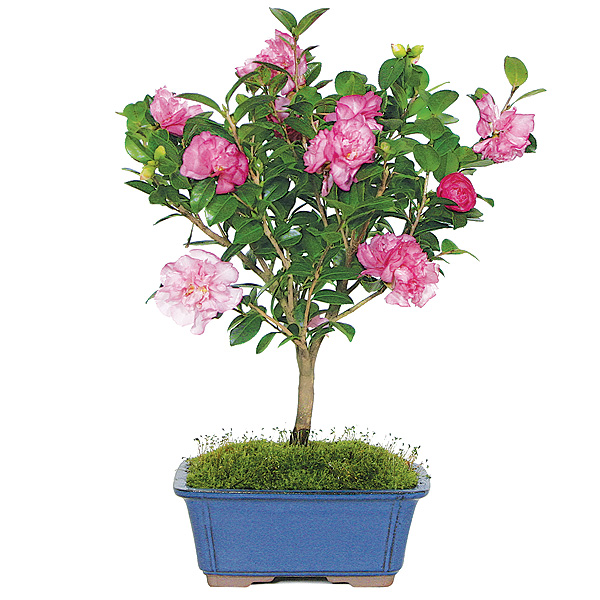
General Background:
The Camellia is native to the mountains of Korea and Japan growing to heights of up to 39 feet. It is also found in Mediterranean countries where it only reaches heights of up to 26 feet. Camellia bonsai are within a family of species which include Camellia sasanqua, Camellia japonica, and Camellia reticulate. Though there are more than 250 species, the most popular choice is the Camellia sasanqua, which is particularly small and hardy. It works well as a bonsai because it has small flowers and leaves which are well suited to bonsai proportions. The Camellia ‘Hot Flash’ will be a welcome addition to any bonsai gardener’s collection with lovely vibrant flowers and a lush canopy of green leaves.
Trees Features:
The Camellia typically has large, glossy leaves that range from medium to dark green. This type of bonsai is favored because of its beautiful blooming season which offers a welcome dose of winter color during the dull days of winter. The ‘Hot Flash’ offers wonderful pink flowers that bloom from fall through early spring against glossy green leaves.
Temperature:
When growing Camellia bonsai, you need to keep the tree in a location that is airy and cool with much light but not direct sunlight. This plant prefers being placed in a partially shady spot in mid spring after the danger of frost is over. It will need to be brought indoors in early fall taking care to move the plant before it begins to develop flower buds or they will tend to fall off
Lighting:
This Bonsai does enjoy bright diffused light, but will not do well in direct sunlight. It prefers diffused morning sun and afternoon shade.
Watering:
Using soft, decalcified water, keep the soil of your Camellia uniformly moist and increase its water in the summer months and while blossoms are flowering. A cooler environment will indicate a need for less water. Your Camellia Bonsai is not drought tolerant and will do poorly if allowed to dry out.
Fertilizing:
The Camilla Bonsai will need to be fed about every two to three weeks during the growing season with a liquid bonsai fertilizer. You will want to stop fertilizing once the winter months of blooming arrive.
Pruning / Training:
You can prune the Camellia during the winter once it has gone through its flowering. After that time, any spent flowers would need to be removed and the tree trimmed to the desired shape. To encourage branching, you will want to prune back the new shoots leaving only two or three leaves in place. You’re your bonsai has reached its desired shape, you will need to prune only once when it is about to bloom as the first shoots appear. Then, leave new shoots in place so that buds have enough time to develop. You can try a number of styles on the Camellia as it is suited for any number of styles, however, the best choices include cascade for the larger trees and an informal upright on single or multiple trunk trees.
Insects / Pests:
Keep in mind that Camellia is quite prone to scale and aphids. You will want to use an organic herbicide or a solution of 1 tsp dish soap to 1 quart warm water sprayed on the foliage until run off occurs. Rinse solution off well, and repeat as necessary. Be sure to avoid spraying the blossoms when in bloom as it will cause browning to occur. In addition, the Camellia is susceptible to viruses, which can cause damage to the beautiful flowers.
Propagation:
To propagate the Camellia, you will want to use cuttings that have become lignified, from winter to summer keeping in mind that root development will be a slow process. You can also propagate successfully with seeds.
Repotting:
Repot the Camellia Bonsai every two to three years, in the early spring months and offer your plant moderate root pruning. When replacing the soil, make sure you use lime-free soil, as it does not tolerate lime.
Additional Comments:
Because its peak bloom time is in December, it offers a perfect holiday alternative to the monotony of poinsettias. Keeping the leaves of your bonsai dust free will go a long way to encourage healthy cell growth which helps your plant to keep your environments air free from toxins. You can do your plant a favor if you keep it in a smoke free location, because plants, just like children and animals, thrive when protected from the effects second and third hand smoke.
DISCLAIMER: The content provided in this article is not warranted or guaranteed by Bonsai Outlet. The content provided is intended for entertainment and/or educational purposes in order to introduce to the reader key ideas, concepts, and/or product reviews. We are not liable for any negative consequences that may result from implementing any information covered in our articles or tutorials. Happy bonsai gardening.



